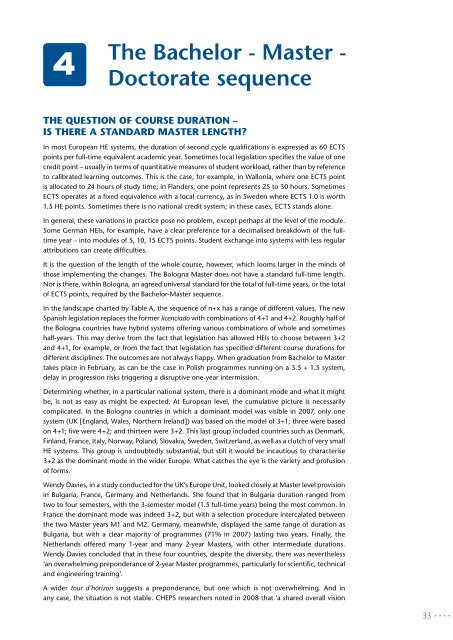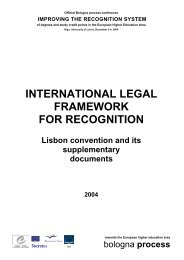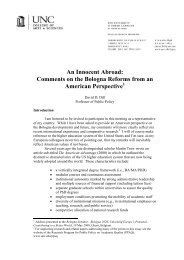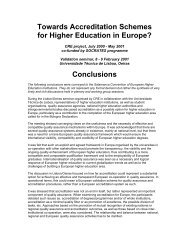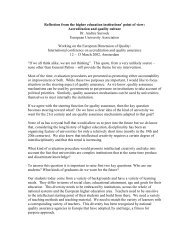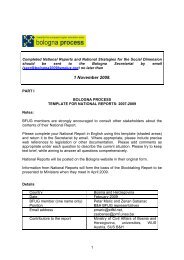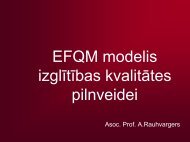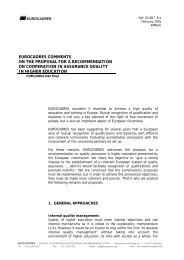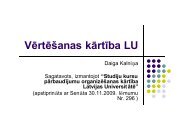EUA Survey Of Master Degrees In Europe - European University ...
EUA Survey Of Master Degrees In Europe - European University ...
EUA Survey Of Master Degrees In Europe - European University ...
You also want an ePaper? Increase the reach of your titles
YUMPU automatically turns print PDFs into web optimized ePapers that Google loves.
4The Bachelor - <strong>Master</strong> -Doctorate sequenceThe question of course duration –is there a standard <strong>Master</strong> length?<strong>In</strong> most <strong>Europe</strong>an HE systems, the duration of second cycle qualifications is expressed as 60 ECTSpoints per full-time equivalent academic year. Sometimes local legislation specifies the value of onecredit point – usually in terms of quantitative measures of student workload, rather than by referenceto calibrated learning outcomes. This is the case, for example, in Wallonia, where one ECTS pointis allocated to 24 hours of study time; in Flanders, one point represents 25 to 30 hours. SometimesECTS operates at a fixed equivalence with a local currency, as in Sweden where ECTS 1.0 is worth1.5 HE points. Sometimes there is no national credit system; in these cases, ECTS stands alone.<strong>In</strong> general, these variations in practice pose no problem, except perhaps at the level of the module.Some German HEIs, for example, have a clear preference for a decimalised breakdown of the fulltimeyear – into modules of 5, 10, 15 ECTS points. Student exchange into systems with less regularattributions can create difficulties.It is the question of the length of the whole course, however, which looms larger in the minds ofthose implementing the changes. The Bologna <strong>Master</strong> does not have a standard full-time length.Nor is there, within Bologna, an agreed universal standard for the total of full-time years, or the totalof ECTS points, required by the Bachelor-<strong>Master</strong> sequence.<strong>In</strong> the landscape charted by Table A, the sequence of n+x has a range of different values. The newSpanish legislation replaces the former licenciado with combinations of 4+1 and 4+2. Roughly half ofthe Bologna countries have hybrid systems offering various combinations of whole and sometimeshalf-years. This may derive from the fact that legislation has allowed HEIs to choose between 3+2and 4+1, for example, or from the fact that legislation has specified different course durations fordifferent disciplines. The outcomes are not always happy. When graduation from Bachelor to <strong>Master</strong>takes place in February, as can be the case in Polish programmes running on a 3.5 + 1.5 system,delay in progression risks triggering a disruptive one-year intermission.Determining whether, in a particular national system, there is a dominant mode and what it mightbe, is not as easy as might be expected. At <strong>Europe</strong>an level, the cumulative picture is necessarilycomplicated. <strong>In</strong> the Bologna countries in which a dominant model was visible in 2007, only onesystem (UK [England, Wales, Northern Ireland]) was based on the model of 3+1; three were basedon 4+1; five were 4+2; and thirteen were 3+2. This last group included countries such as Denmark,Finland, France, Italy, Norway, Poland, Slovakia, Sweden, Switzerland, as well as a clutch of very smallHE systems. This group is undoubtedly substantial, but still it would be incautious to characterise3+2 as the dominant mode in the wider <strong>Europe</strong>. What catches the eye is the variety and profusionof forms.Wendy Davies, in a study conducted for the UK’s <strong>Europe</strong> Unit, looked closely at <strong>Master</strong> level provisionin Bulgaria, France, Germany and Netherlands. She found that in Bulgaria duration ranged fromtwo to four semesters, with the 3-semester model (1.5 full-time years) being the most common. <strong>In</strong>France the dominant mode was indeed 3+2, but with a selection procedure intercalated betweenthe two <strong>Master</strong> years M1 and M2. Germany, meanwhile, displayed the same range of duration asBulgaria, but with a clear majority of programmes (71% in 2007) lasting two years. Finally, theNetherlands offered many 1-year and many 2-year <strong>Master</strong>s, with other intermediate durations.Wendy Davies concluded that in these four countries, despite the diversity, there was nevertheless‘an overwhelming preponderance of 2-year <strong>Master</strong> programmes, particularly for scientific, technicaland engineering training’.A wider tour d’horizon suggests a preponderance, but one which is not overwhelming. And inany case, the situation is not stable. CHEPS researchers noted in 2008 that ‘a shared overall vision33


